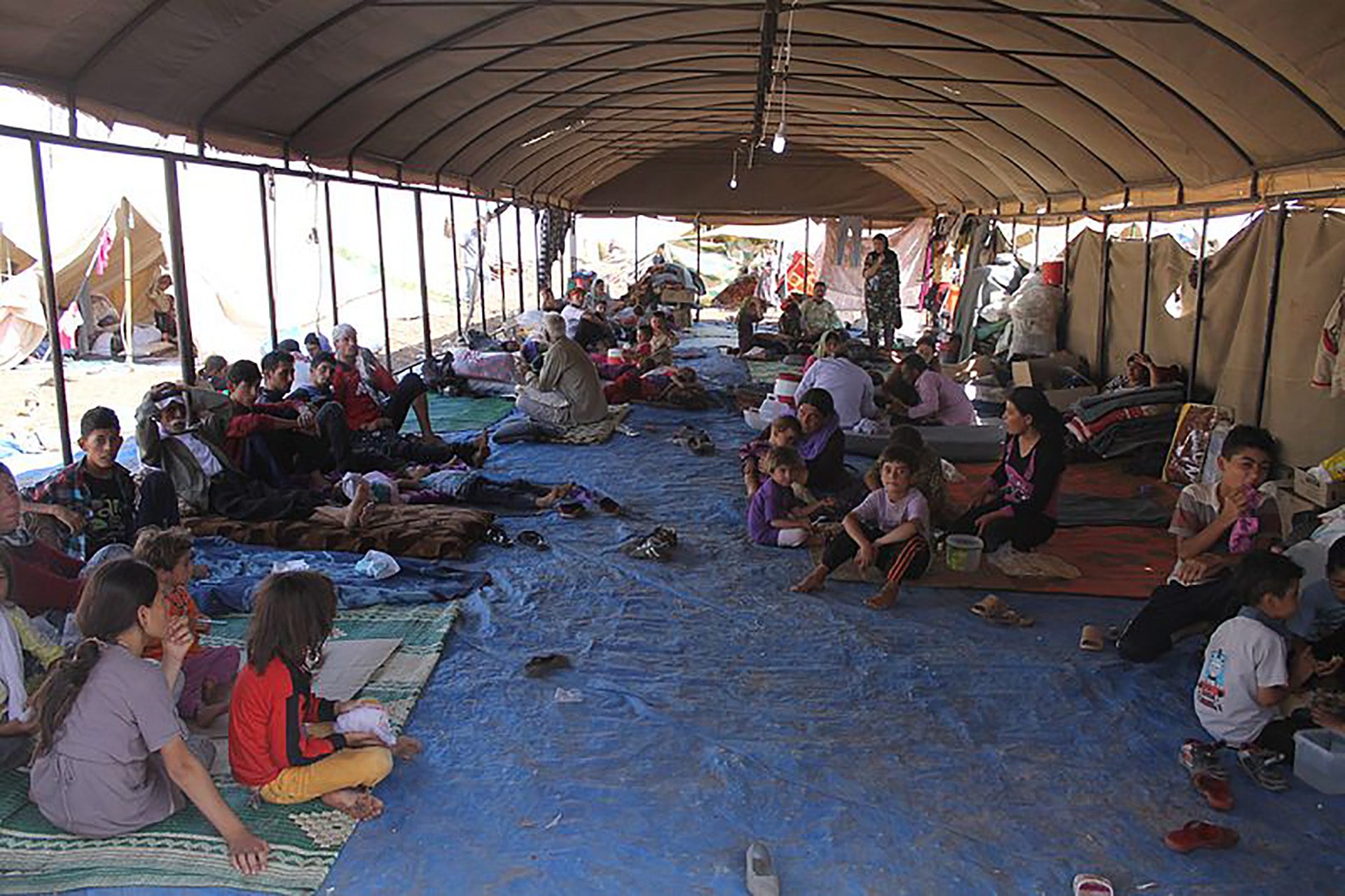
Photo by Rachel Unkovic/International Rescue Committee, sourced via Wikimedia Commons.
Research and writing by Hunter Zhao and Samantha Šoletić-Owens
As the sun set on August 2nd, 2014, the Yazidis of Sinjar began to wrap up their daily activities; like any other day, the children went to school, the farmers tended to their fields, and the doctors treated patients. It was well known that the Islamic State of Iraq and the Levant (ISIL) had seized Mosul, the key to the Sinjar region, by early June 2014. However, the incredible suffering, atrocities, and violence of tomorrow could not have even been imagined. By dawn, ISIL forces invaded Yazidi towns and villages around the base of Mount Sinjar. Abandoned by the Peshmerga, Iraqi Kurdish forces, the Yazidis of Sinjar became easy targets for ISIL fighters. With no warning or alerts to evacuate, thousands of Yazidis were immediately captured by ISIL forces. The terrorist organization then divided the population based on age and gender. Those who were able to escape the onslaught found themselves besieged on the upper plateau of Mount Sinjar with no access to food, water, and medical care. August 3rd became a critical juncture for the Yazidi of Sinjar; a day that would mark the death of thousands and the beginning of a life deprived of humanity for those who were captured.
The Yazidi are an ethno-religious minority, with their ancestral roots in ancient Mesopotamia, modern-day Iraq, Turkey, Syria, and Iran. Today, the majority of Yazidis live in northern Iraq, with smaller communities present in Syria, Armenia, and Georgia and a diaspora population in Western Europe. Their numbers are difficult to estimate, with official estimates of Yazidis living in Iraq ranging everywhere from 70,000 to 500,000. The Yazidis practice Yazidism (a form of Yazdanism), an ancient monotheistic religion that combines aspects of Judaism, Christianity, Islam, and Zoroastrianism. Based on misinterpretations and misrepresentations of the Yazidis’ religion, they have long been persecuted as ‘devil worshippers’ across the region and were subject to at least 72 genocidal massacres during the Ottoman Empire. Despite various state-sanctioned violence against the Yazidis, historically, their day-to-day existence was one of tolerance and cooperation with their Sunni Muslim neighbors. While intermarriage was rare, friendships and working relationships were common between Yazidis and Sunnis, who often lived in close proximity to one another.
As ISIL strengthened their grip on Iraq and Syria in 2014, they made ‘purifying’ their self-styled caliphate of those they viewed as heretical, including Christians, Shiite Muslims, Kurds, and Yazidis, a violent priority. Against the backdrop of long-occurring persecution, ISIL descended on the Yazidis of Sinjar on that day in August of 2014, set on ridding their territory of those they deemed unworthy of life.
ISIL’s calls for ethnic cleansing of the Yazidi reached a climax as the thousands of Yazidi civilians fled to take refuge on Mount Sinjar. Between August 3rd and 5th, thousands fleeing at lower ground levels were captured and nearly all villages were emptied. In the days following, American, Iraqi, British, French and Australian forces airdropped food, water, and aid to the stranded people, while the Kurdistan Workers’ Party (PKK) assisted in providing humanitarian aid and setting up refugee camps for more than 3,000 Yazidi.
On the 10th of August, the Iraqi government reported that ISIL had buried an undetermined number of Yazidi women and children alive, providing further proof that the violence against the Yazidi was, in fact, genocide. Following these reports, the Arab League condemned ISIL’s perpetration of crimes against humanity, while the UN deemed the violence a “Level 3 Emergency,” the highest designation of a humanitarian crisis. While local Kurdish forces led the evacuation of Sinjar’s Yazidis, ISIL continued to burn Yazidi villages, kill Yazidi civilians (chiefly men and boys), and kidnap and enslave Yazidi women and girls.
Since 2014, nearly 10,000 Yazidis have either been killed or kidnapped by ISIL, though exact figures may never be known. Of this number, an estimated 3,100 were killed during those fateful August days in Sinjar. Currently, 3,410 Yazidis, mainly women and girls, remain in ISIL captivity. Girls and women in custody are routinely beaten, raped, impregnated, sold, and traded by ISIL fighters. Those who have either been released or have escaped are extremely traumatized; physically, mentally, and emotionally. According to the New York Times, many recent escapees women also show unusually high levels of indoctrination. Reporter Rukmini Callamachi cites an example of two Yazidi sisters who escaped to a refugee camp in northern Iraq who continually referred to their captors as their ‘husbands’ and ‘martyrs.’
Despite condemnation by the United Nations and other international bodies over genocide and crimes against humanity, and the official OHCHR designation of the persecution of the Yazidi as genocide, no court of law has sought any prosecution for the crimes committed against the Yazidi people as of September 2017. The Iraqi government has not yet submitted the necessary paperwork to trigger an investigation from the United Nations Security Council; without a letter, the international prosecution of ISIL members remains uncertain. Considered the savior of thousands of lives by the Yazidi, the the PKK, which had helped carve an escape route for those trapped on Mount Sinjar to Syria is now being expelled by both the Kurdistan Regional and Turkish governments, who consider the PKK to be a terrorist organization. In April, Turkish air forces began bombing PKK forces in the Sinjar region, potentially jeopardizing the safety of the remaining Yazidis. Once home to (an estimated) over 360,000 Yazidis, residents of the Sinjar region are now scattered in camps across northern Iraq still in search of a safe haven.
To learn more about the foundations and key events of the genocide, we recommend the following articles:
http://www.reuters.com/article/us-mideast-crisis-turkey-iraq-idUSKBN17R0D2
http://edition.cnn.com/2017/03/19/middleeast/nadia-murad-amal-clooney-cnntv/
http://www.ohchr.org/Documents/HRBodies/HRCouncil/CoISyria/A_HRC_32_CRP.2_en.pdf


